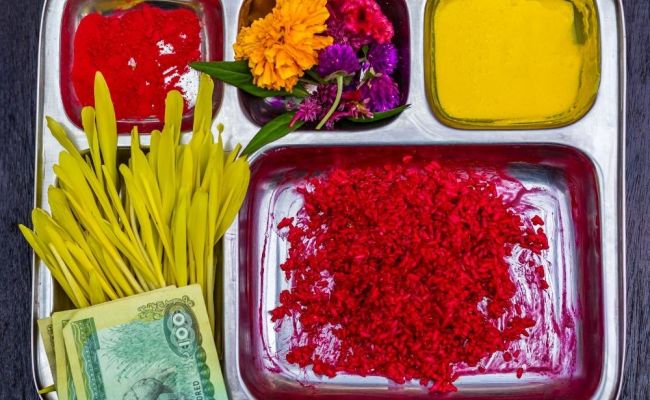Dashain is the biggest festival in Nepal which is celebrated for 15 days. It is celebrated by the Hindus in Nepal. It is also celebrated by Nepali-Indian people who live in Sikkim, Assam, and Darjeeling districts of India. Lhotshampa people in Bhutan and Burmese Gurkhas in Myanmar also celebrate this festival.
It is the longest festival in the Bikram Sambat and Nepal Sambat yearly calendar. The festival is 15 days long; the first, seventh, eighth, ninth, tenth, and fifteenth days are the most important. It is regarded as the biggest and most important festival in Nepal. It falls in September or October (Ashwin or Kartik in the Bikram Sambat calendar). It starts from the bright lunar fortnight of Ashwin and ends on Purnima (full moon day). This festival is the symbol of victory of good over evil.
It brings Nepalis in Nepal and abroad together and provides a sense of unity. For this reason, the importance of Dashain has gone up at a time when disunity and fractured relations have become much more common.
The Important Days of Dashain
Ghatasthapana- The first day of Dashain is called Ghatasthapana, which represents the Ghada/Kalash—a holy vessel or pot, and people sow Jamara. The Kalash represents the purity of Durga and is worshipped twice during the day, often by the eldest male in the household. Over the next several days, yellow grass is sewn and begins to grow.
Fulpati– It is the seventh day of Dashain and is celebrated by cleaning and then decorating the household. A fulpati parade is often held and is attended by the President and many other government officials and is arranged by the Nepal Army. There has been a centuries-long tradition of firing in honour of the celebration for ten minutes. Before the President, the Royal King would oversee the celebrations.
Maha Ashtami- The eighth day of Dashain is known as Maha Ashtami. This is the day where both Durga and Kali are worshipped by devoted followers to mark the most fierce creation of Durga’s power, Kali, who appeared from the sacrifices of animals. Thus, worshippers often sacrifice blood as a blessing for fertility. Furthermore, in more recent times, people often eat the meat of goats, ducks, and buffaloes, all in honour of Kali. This food will carry on until the fifteenth day, showing the power of the manifestation of the goddess.
Maha Navami- The ninth day, Maha Navami, is highly important as the preparations reach their peak, and temples for both Kali and Durga are often laden with sacrifices and gifts. It can also be known as the Tika day. This provides a day to worship and appreciate all machinery and mechanical household items like cars, knives, axes, and buses.
Vijaya Dashami- The tenth day brings the origin of Dashain, also known as Vijaya Dashami, and is the most celebrated day with food, gifts, and money, often by the eldest person in the house, regardless of gender. Here, all the previous days of celebrations are tied together by offering Tika, Jamara, and Dakshina (money).
Kojagrat Purnima- Day fifteen is called Kojagrat which often falls on a full moon. Kojagrat translates to “who is awake”, and most worshippers stay awake all night due to a legend that says wealth will be bestowed to those who stay awake all night by Laxmi, the Goddess of Wealth.
How do People Celebrate the Dashain Festival in Nepal?
Dashain celebrations involve various customs and traditions. Here are ten ways people celebrate Dashain in Nepal.
1. Family Reunions
During Dashain, family members come together, often traveling long distances to celebrate with their loved ones. It’s a time for family bonding and togetherness. This is particularly important as many Nepalis are outside the country for employment.
2. Flying Kites
Kite flying is a popular tradition during Dashain. People of all ages fly colorful kites, and competitions are held among kite flyers. Hindus believe that the flying kites send a message to the rain god to stop sending more rain.
3. Swings (Ping)
Swing sets are erected in many public places, and people, especially children, enjoy swinging on them. It’s a symbol of fun and festivity. You can see traditional temporary swings made from bamboo and ropes. In cities, there are modern swings different from traditional ones.
4. New Clothes and Gifts
People wear new clothes during Dashain and exchange gifts among family and friends. This symbolizes the renewal of relationships. The children mostly enjoy their new clothes. We believe that this tradition of wearing new clothes began when the clothes were not very affordable.
5. Tika and Jamara
Elders bless the young ones by applying Tika (a mixture of yogurt, rice, and vermillion) and placing Jamara (barley grass) on their foreheads. This symbolizes protection and good fortune.
6. Animal Sacrifice
Sacrificing animals like goats, buffaloes, or chickens to honor the goddess Durga is quite common. The meat is then shared among family and friends. Vegetarians cut vegetables as a symbol of offering to Durga.
7. Card Games and Gambling
Though illegal, people do gamble in Dashain. It’s a time when people enjoy friendly competitions and games. You can observe several types of gambling, like cards, kauda, and Langur Burja during Dashain.
8. Visiting Temples and Shrines
Many people visit temples and shrines to seek blessings and offer their prayers to the goddess Durga. Nepal has thousands of temples in each and every corner of the country, especially in the Kathmandu Valley.
9. Music and Dance
Festive music and traditional dances are performed in various communities. It’s a time for cultural expression and entertainment. You can hear special celebratory tunes throughout Nepal during Dashain.
10. Feasting
No festival is complete without good food. Dashain is a time of indulgence in delicious Nepali cuisine. Families prepare elaborate feasts with dishes like sel roti, mutton curry, and sweets.
